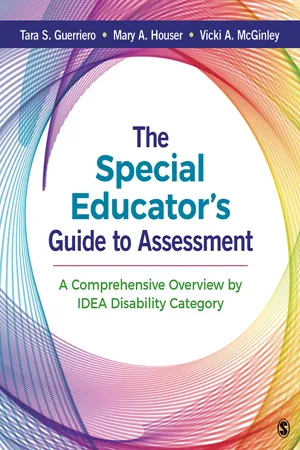
The Special Educator′s Guide to Assessment
A Comprehensive Overview by IDEA Disability Category
- 504 pages
- English
- ePUB (mobile friendly)
- Available on iOS & Android
The Special Educator′s Guide to Assessment
A Comprehensive Overview by IDEA Disability Category
About this book
Special education students often learn about the characteristics of disabilities, but can lack an understanding of the relationship between diagnostic assessment and eligibility for special education services. The Special Educator?s Guide to Assessment: A Comprehensive Overview by IDEA Disability Category focuses on the role that assessment plays in the diagnosis of a disability, determination of eligibility for special education services, and education of students with disabilities to provide a meaningful interconnection between assessment concepts and classroom application for teachers. Authors Tara S. Guerriero, Mary A. Houser, and Vicki A. McGinley want to ensure that future special education teachers have the preparation to provide comprehensive instruction to P-12 students through this text.
While special education teachers are often not the ones conducting comprehensive evaluations, it is paramount that they understand their students' individual characteristics, and understand how assessment is used to determine diagnosis and eligibility. Framing the text around The Individuals with Disabilities Act (IDEA) provides students with concrete standards by which all disabilities are evaluated and regulated in our public educational system.
Part I introduces the basic topics of assessment, ethics, and assessment types. Part II moves on to provide diagnostic and eligibility criteria according to IDEA categories that are most commonly diagnosed in an educational setting while Part III describes the criteria for IDEA categories most commonly diagnosed in a medical setting. Features like case studies and sample comprehensive evaluations help bring to life assessment and how it applies in real classrooms.
The password-protected Instructor Resource Site (formally known as SAGE Edge) offers access to all text-specific resources, including a test bank and editable, chapter-specific PowerPoint® slides.
Frequently asked questions
- Essential is ideal for learners and professionals who enjoy exploring a wide range of subjects. Access the Essential Library with 800,000+ trusted titles and best-sellers across business, personal growth, and the humanities. Includes unlimited reading time and Standard Read Aloud voice.
- Complete: Perfect for advanced learners and researchers needing full, unrestricted access. Unlock 1.4M+ books across hundreds of subjects, including academic and specialized titles. The Complete Plan also includes advanced features like Premium Read Aloud and Research Assistant.
Please note we cannot support devices running on iOS 13 and Android 7 or earlier. Learn more about using the app.
Information
Table of contents
- Cover
- Half Title
- Publisher Note
- Title Page
- Copyright Page
- Brief Table of Contents
- Detailed Contents
- Preface
- Acknowledgments
- About the Authors
- Part I An Overview of Assessment in Special Education
- Chapter 1 Introduction to Special Education History, Legislation, and Consideration for Eligibility
- Chapter 2 Introduction to Assessment and Ethical Considerations
- Chapter 3 Assessment Types
- Chapter 4 Assessment for Diagnosis and Eligibility: Development and Health
- Chapter 5 Assessment for Diagnosis and Eligibility: Academic Achievement and Behavior
- Part II Assessment and Diagnosis of Disabilities
- Chapter 6 Learning Disabilities
- Chapter 7 Intellectual Disabilities
- Chapter 8 Autism Spectrum Disorder (ASD)
- Chapter 9 Speech or Language Impairment
- Chapter 10 Emotional Disturbance
- Part III Medically Diagnosed Disabilities
- Chapter 11 Attention-Deficit/Hyperactivity Disorder (ADHD)
- Chapter 12 Sensory Impairments (Including Visual Impairment, Hearing Impairment, Deafness, and Deaf-Blindness)
- Chapter 13 Health-Related Disabilities (Including Other Health Impairments, Orthopedic Impairment, Traumatic Brain Injury, and Multiple Disabilities)
- Part IV Making Connections Between Diagnosis, Eligibility, and Instruction
- Chapter 14 Making Connections Between Diagnosis, Eligibility, and Instruction
- Name Index
- Subject Index